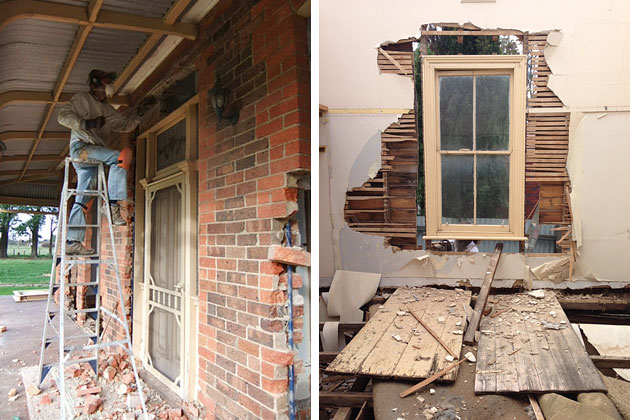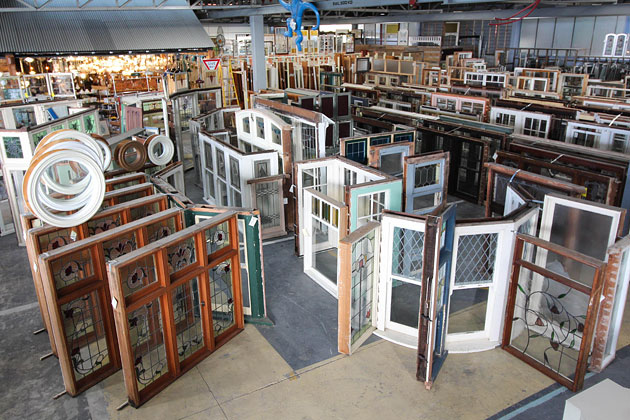

As the world talks sustainability, more and more Australians are visiting salvage yards for recycled building materials and reusable ingredients. What some aren’t expecting is the price of ‘old junk’. There are quiet grumbles of yards pricing up for the latest trends.
When you speak to salvage owners, however, the reality is quite different. Rising labour costs, increased competition and expensive overheads means many yards are closing down, or working harder and smarter to stay in business.
Many people don’t realise that salvage yards buy stock like any other retailer. Unlike council drop-off points, private yards arrange to purchase and collect materials from demolishers and home owners before buildings are ripped apart and damaged by demolition machinery.
Once a quote is agreed upon, many yards send their own deconstruction crew to strip the building and salvage everything they can. Lifting floorboards, dismantling roofing and framing, removing heritage doors and windows, stripping kitchens and bathrooms, cleaning recycled bricks, denailing timber and transporting building materials are all tough, physical jobs that need to be fairly paid. Training and keeping reliable staff is one of the biggest costs for salvage businesses.
Like most retail businesses rent is the next major overhead. With undercover warehouse space running to $100/square metre, a city yard trading from 2000m2 undercover and 4000m2 handstand has a considerable storage bill.
Add inventory, moving trucks, insurance, advertising, website, and online/offline customer service and junk yards have a hard slog to cover costs.
10 years ago salvaged items were taken off the back of a truck and stacked for sale. Now recycled timber racks look a lot like hardware shelves with neatly sorted, docked and de-metalled lengths. Progressive yards also spend time cleaning, repairing, photographing and cataloguing every salvaged item online. For customers it saves loads of scouting time. For yards it requires more staff, more IT hardware, and more sophisticated website design.


Tony Green, a manager at Renovators Paradise in Melbourne, says there’s been a major change in clientele in the last decade.
“10 years ago, I would say 80% of our customers were tradesmen looking for doors and timber. Now in 2017, 50% of people that visit our (non smoking, no bare feet, no dogs) showroom and make enquiries or purchases online are female.
We also have a very strict policy of having items safely secured and strapped up so the youngsters don’t get into trouble. Mums with kids visit us every day, many of them with teenage daughters and sons who find that weird or cool item from yesteryear.”
Since 2000 the value of renovation building approvals has more than doubled in Australia.* High stamp duty costs and the popularity of renovation television has encouraged millions of families to extend or alter their existing home rather than sell and move.
Enthusiastic renovators, and growing interest in ‘green’ building, has had a positive effect on salvage yard sales. Tony Green says the top 4 reasons customers choose secondhand materials over new are:
1. To extend or patch existing heritage flooring. New flooring simply doesn’t match original flooring in colour, density or overall look.
2. To find affordable alternatives for expenses like custom windows and doors, or DIY ingredients for home projects with limited budgets.
3. The bargain factor
“People for years have come to demolition yards trying to find a bargain. Even though we have moved on from the title ‘demolition yard’ to ‘showroom’, folks know they can visit us and pick up that odd or rare item they won’t find anywhere else.”
4. An active preference for recycling
“We hear comments every day saying it is ‘criminal’ and ‘sad’ that houses are being demolished without some sort of salvage.”
Organising yards and making it easy for inexperienced or design-based customers to find materials has broadened the whole customer base.
There’s no doubt the internet age is changing the salvage industry. Globally, we’re seeing increased environmental awareness and collaboration on resource management. Locally, we’re seeing younger salvage teams adjusting to 21st century customers with online catalogues and shipping.
Smart yards will be looking at delivery superpowers like Amazon entering Australia and their impact on shopping behaviour. Whether high overhead walk-in yards will be around in 10 years, or move totally online, remains to be seen.
Also ahead is the possibility of deconstruction legislation. The world needs alternatives to high levels of construction and demolition waste and many countries are introducing mandatory deconstruction for reusable materials. If that happens in Australia our relatively small salvage industry will find the sand shifting once again.


The Junk Map communicates with a lot of salvage businesses and there is never a fast-money mentality. Stock can lie in a yard for years before it finds the right buyer. Most salvage teams work incredibly hard in a field they see as worthwhile. They save tonnes of old growth Australian timbers, and thousands of handcrafted heritage features, from landfill and waste. We need to value their contribution and pay a fair price for the treasures they uncover.
Photo references:
1. Church porthole window salvaged by Renovate Restore Recycle, Bendigo.
2. Pre-demolition strip out, Renovate Restore Recycle, Bendigo.
3 & 4. Pre-demolition strip out, Renovators Paradise, Melbourne.
5 & 6. Salvaged fittings, Renovators Paradise, Melbourne.
* Capuano, G. (2016), Where is Australia’s renovation capital?, .id the population experts. [Accessed March 2017]